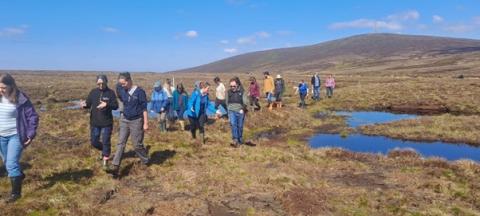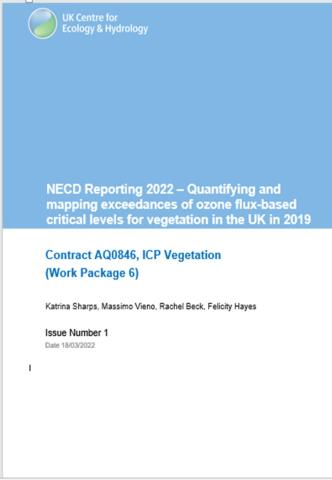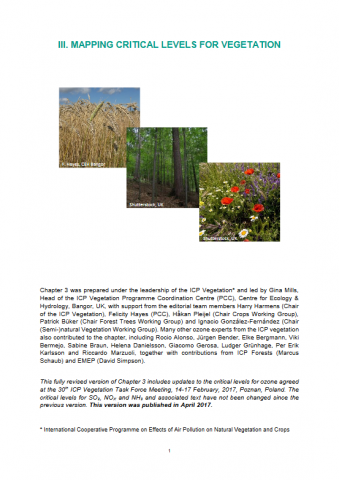
May 8th -May 9th, Dublin, Republic of Ireland.
Mike Perring, UKCEH Bangor
The latest annual Community of Air Pollution Effects Researchers (CAPER) meeting took place in Dublin in May 2025. Thanks to the prompting of Katie Wyer, and the organisation and encouragement of Dáithí Kelleghan (Environmental Protection Agency, Ireland), Thomas Cummins and Tom Curran (University College Dublin), and Felicity Hayes (UKCEH and ICP Vegetation chair), this was the first visit of CAPER to the Emerald Isle.
There was much anticipation as nearly 40 registered participants arrived from various locations across Ireland and the UK, on two or four wheels, planes and boats. Old friendships were renewed and new acquaintances made, as day 1 gave way to day 2 through, for those able to stay, the conference dinner, an evening listening to Irish music, and the Friday morning bus trip to Liffey Head Bog – where we saw the other black (dark) stuff that Ireland is famous for (see Murray 2018). The conference was rounded off with a lunch at the Armoury Café at the Glencree Centre for Peace & Reconciliation.
This progression highlights the programme’s transition from negative impacts to recovery. On Day 1, 15 talks and 3 posters were presented at Wynn’s Hotel on the northside of the River Liffey, with early contributions exploring negative impacts of air pollutants, including ozone, nitrogen, heavy metals and particulate matter. The day finished with a session of talks asking how stakeholders can use (and abuse) tools such as APIS, and how we measure and conceptualise recovery. Governments want to see signs of progress in reaching biodiversity and emission goals as international policies continue to cut emissions, atmospheric pollutant profiles change from earlier decades, and organisms within and across habitats and trophic levels experience rapidly changing environmental conditions. Understanding recovery dynamics, and which indicators respond to declining air pollutant pressures, can help measure that progress.
The River Liffey in Dublin on the morning of the CAPER conference. Photo credit: Mike Perring
Day 2, and the field trip, mirrored a journey going from (negative) impact to recovery, with its visit to Liffey Head Bog in the Wicklow Mountains National Park. As well as getting close to the source of the Liffey, the group had the benefit of Andrea Webb’s knowledge, Ranger with the National Parks and Wildlife Service, as they shared the National Park’s approach and their perspectives on habitat restoration on a formerly degraded blanket bog ecosystem that had been drained when part of the Powerscourt Estate. We were able to observe how former drainage channels have now been blocked using an array of techniques, including timber, plastic and coir material, with much “learning by doing” and careful deployment of heavy machinery. Signs of recovery could be seen with pooled water, despite the preceding dry conditions, and populations of different Sphagnum species. These include Sphagnum cuspidatum - which looks like wet fur because of its very fine leaves, and S. auriculatum - with its distinctive cow horn shaped upper branches, becoming prevalent in the pools. Large brown-green S. papillosum and small wine-red S. rubellum, both good peat-forming species, were found on wetter areas of peat. Mustard green S. fallax, which requires higher nutrients than found on the rainwater fed peat, was present in flushed areas with rushes at the head of the River Liffey.
Top left: S. auriculatum - with its distinctive cow horn shaped upper branches.
Top right: Sphagnum cuspidatum - which looks like wet fur because of its very fine leaves.
Bottom left: Large brown-green S. papillosum.
Bottom right: Small wine-red S. rubellum. All photo credits and © Joanne Denyer.
In addition, we were able to see one of Ireland’s National Ecosystem Monitoring Network sites, which had been introduced the day before, with an array of equipment including a set of three passive ALPHATM samplers for monitoring ammonia, habitat quadrats for vegetation, soil gas collars and piezometers. The trip finished with lunch at Glencree where we could read about its role as a refuge after the Second World War for German children. Its role now and for the past 50 years - it being founded in 1974, 5 years before the Long-Range Transboundary Air Pollution treaty - has been to encourage social recovery through dialogue and shared learning.
Across the two days, much was raised to ponder. During the field trip, I was particularly struck with the ownership differences between Irish and British national parks, where Irish parks are owned by the managing authority. I wondered what difference that could make to recovery from, and management of, air pollution sources and the types of interventions that are permitted and at what scale. Also striking was hearing about how we had travelled along an old military road to access the site. That opening up of the area led to increased peat extraction – for me, providing parallels with research highlighting the importance of roads exacerbating habitat loss the world over. On Day 1, I was struck by the very first talk of the day describing the fact that although PM2.5 (particulate matter of less than 2.5 microns) in rural towns and nitrogen dioxide (NO2) in cities in Ireland are local challenges, people generally perceive air quality as an issue of declining importance and, where there is an issue, that it is at the national scale. I also learned a lot: for instance, how drones equipped with appropriate sensors may pick up ammonia emission hotspots and enhance connection with farmers and other stakeholders through visual impact, to taking on board the need to be methodologically consistent in describing spatial emissions data to understand N impacts on systems. I also learned about the ongoing challenge of deposition velocities being generally calculated in a very different atmosphere than currently. These learnings were complemented by a model chain approach to understanding air pollution effects on species abundance to tackle a policy aim from the UK Environment Act of a 10% increase in species populations by 2042.
So, as we considered impact to recovery under changing environmental conditions, I wonder: if certain air pollutants decrease, particularly nitrogen-containing compounds, will the Emerald Isle’s green hue change? The answer to that may depend on the trends in Ireland’s cattle herd and their impacts on protected sites (as described by Katie), as well as through wider trends in agricultural and industrial activities. Whatever moves made, I imagine the black stuff, and the dark stuff, will remain important for social and ecological cohesion, for many years to come.
Acknowledgements
Thanks to all those who made CAPER such an interesting and welcoming meeting, especially Felicity and the local organisers, Thomas, Tom and Dáithí. Thanks also to Joanne Denyer for providing information and the photographs on the Sphagnum species described herein.
References
Murray, D.S. 2018 The Dark Stuff: Stories from the Peatlands, Bloomsbury Publishing: London.


